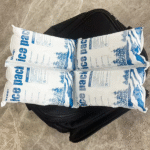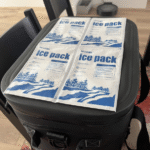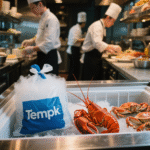Cómo empacar alimentos congelados con hielo seco correctamente: A 2025 Guía
Packing frozen food with dry ice correctly is crucial to ensuring your products stay frozen during transit while also adhering to safety regulations. En esta guía, you’ll find a step-by-step breakdown of the process, los mejores materiales de embalaje, cálculos de hielo seco, precauciones de seguridad, y cómo cumplir con 2025 regulaciones. Mantenga sus envíos en óptimas condiciones y cumpla con todos los requisitos reglamentarios y de transportista.
-
How to calculate the correct amount of dry ice for safe packing
-
Best packaging and insulation methods to prevent sublimation
-
Key labeling rules and compliance steps to avoid costly mistakes
-
Cómo 2025 innovations in cold chain technology can make your shipments smarter and greener
How Much Dry Ice Should You Use to Pack Frozen Food?
Respuesta central:
The amount of dry ice needed depends on several factors: the weight of the product, the duration of transit, y la temperatura ambiente. A general rule is to plan for 5–10 libras de hielo seco por 24 horas of transit for every 10-15 lbs of frozen food. If the package is poorly insulated or the environment is hotter, Puede que necesite más.
Ejemplo de cálculo de hielo seco
Por un 2-tránsito diurno con 5 kilos (11 libras) of frozen food:
Hielo seco (libras) = Product Weight (kilos) × 1.1 × Transit Days × Safety Buffer
= 5 kilos × 1.1 × 2 días × 1.15 = 12.7 libras de hielo seco.
Explicación & Conocimiento:
El hielo seco sublimate (gira de sólido a gas), meaning it gradually loses mass over time. The better your insulation and the lower the ambient temperature, cuanto más lenta es la sublimación. Always factor in a margen de seguridad to account for delays or inefficiencies in insulation.
| Peso del producto | Tiempo de tránsito | Se requiere hielo seco | Beneficio |
|---|---|---|---|
| 5 kilos | 2 días | 12.7 libras | Keeps products frozen with buffer for delay |
| 2 kilos | 1 día | 3–4 lbs | Maintains solid freeze even with 8-hour delay |
| 5 kilos | 2 días + buffer | 14–15 libras | Covers unexpected temperature spikes |
What Packaging and Venting Methods Ensure Safe Shipping?
Respuesta central:
For the best dry ice shipping, usar un multi-layer insulation system with proper venting. The outer box should be rigid (corrugated or fiberboard), and the inner insulation should consist of Espuma EPS (poliestireno expandido) o personaje (paneles aislados al vacío). Nunca selle el paquete herméticamente, as dry ice generates gas, which must escape to avoid pressure buildup.
Venting and Distribution Tips:
-
Desfogue:
Leave small vent holes (alrededor 5–8 mm) for the CO₂ gas to escape. Ensure the liner is loosely closed but not sealed. -
Colocación de hielo seco:
Coloca el hielo seco en la parte superior y los lados of the frozen food, not beneath it, to ensure cold air sinks properly and surrounds the product. -
Voids and Space Filling:
Usar espuma, kraft paper, or air pillows to fill any gaps inside the package. This reduces airflow and helps keep the temperature stable.
Example in Practice:
A frozen food company optimized its dry ice use by adding extra insulation and repositioning dry ice in perforated bags. They improved the freezing duration by 15% and cut waste by 10%.
What Are the Key Labeling and Documentation Requirements?
Respuesta rápida:
Para envíos aéreos, dry ice must be labeled as “Hielo seco / Dióxido de carbono, Sólido (UN1845)” con el peso neto claramente marcado. Shipments containing more than 5.5 libras (2.5 kilos) of dry ice must also include a Clase 9 Hazard Diamond. Keep all documentation updated to avoid shipping delays.
Requisitos específicos del operador:
-
UPS y FedEx:
Both require notación de carta de porte (“Hielo seco, UN1845, peso neto”) and proper labeling for hazardous goods. -
IATA and DOT Rules:
Para envíos internacionales, comply with Aquí está Pi 954 y Regulaciones del DOT. Always double-check the specific limits of each carrier.
Why Proper Labeling Matters:
Incorrect or missing labeling can result in costly fines, retrasos, or even the rejection of your shipment. A Y 1845 etiqueta ensures that your dry ice is handled as a hazardous material according to legal requirements.
What Are the Safety Precautions You Should Take When Handling Dry Ice?
Respuesta central:
Dry ice is hazardous due to its extreme cold and the CO₂ gas it releases as it sublimates. Siempre usa guantes aislados, gafas de protección, y protective clothing al manipular hielo seco, and ensure the workspace is well-ventilated. Nunca selle el hielo seco en recipientes herméticos., as the buildup of gas can cause explosions.
Safety Best Practices:
-
Usar PPE (Equipo de protección personal):
Wear insulated gloves and eye protection at all times when handling dry ice to avoid frostbite or injury from cold exposure. -
Ventilación:
Ensure all dry ice handling is done in áreas bien ventiladas para evitar la acumulación de CO₂, que puede desplazar el oxígeno y causar asfixia.. -
Eliminación adecuada:
Allow dry ice to sublimate in an outdoor area that is well-ventilated. Never dispose of dry ice down drains or seal it in containers.
Ejemplo del mundo real:
A food logistics company had a 30% reduction in handling injuries after implementing strict entrenamiento de seguridad y ventilation protocols.
How Do You Handle 2025’s Innovations in Cold Chain Shipping?
Descripción general de la tendencia:
As technology advances in 2025, smarter cold chain solutions are emerging. This includes AI-driven coolant dosing, smart packaging systems that track temperature in real-time, y eco-friendly liners that help reduce environmental impact.
2025 Innovación:
-
AI-driven temperature management: Predicts sublimation rates and adjusts dry ice amounts accordingly.
-
Embalaje inteligente: Los sensores integrados rastrean la temperatura, ensuring constant monitoring during transit.
-
Materiales sostenibles: Use of aislamiento biodegradable y hielo seco neutro en carbono está en aumento, Reducir los desechos y las huellas de carbono.
Insight del mercado:
With the rise in e-commerce frozen food shipments, customers expect zero-melt entregas. Cold chain providers are increasingly adopting these innovations to improve temperature control, Reducir el desperdicio, y conocer sustainability goals.
Preguntas frecuentes
Q1: ¿Cuánto dura el hielo seco en tránsito??
El hielo seco puede durar 24–72 horas depending on the insulation and amount used. Always add extra for buffer time.
Q2: Can I ship dry ice in personal luggage?
Sí, but only up to 2.5 kilos (5.5 libras) with advance approval from the airline. Ensure the bag is vented and properly marked.
Q3: How do I calculate dry ice for my shipment?
Usa la fórmula:
Hielo seco (libras) = Peso del producto (libras) × 1.1 × transit days × 1.15 amortiguador de seguridad.
Resumen y recomendaciones
To pack frozen food with dry ice properly, always calculate the right amount of dry ice, choose appropriate packaging, and ensure proper labeling. Para 2025, adopting smarter, more sustainable technologies will enhance efficiency and compliance. Keep safety a priority by following best practices for handling and venting dry ice.
Siguientes pasos:
-
Review your packing methods and integrate AI-powered or smart packaging for better temperature monitoring.
-
Update your Sops con 2025 guidelines and conduct training sessions on dry ice handling.
-
Ensure compliance with all regulations and carrier requirements to avoid delays.
Acerca de Tempk
Y tempk, we specialize in cold chain packaging solutions that reduce dry ice waste by up to 30% while maintaining compliance and performance. Our designs are tailored to meet the stringent requirements of air and ground shipping in 2025. Contact us for a personalized consultation to optimize your shipments.
























